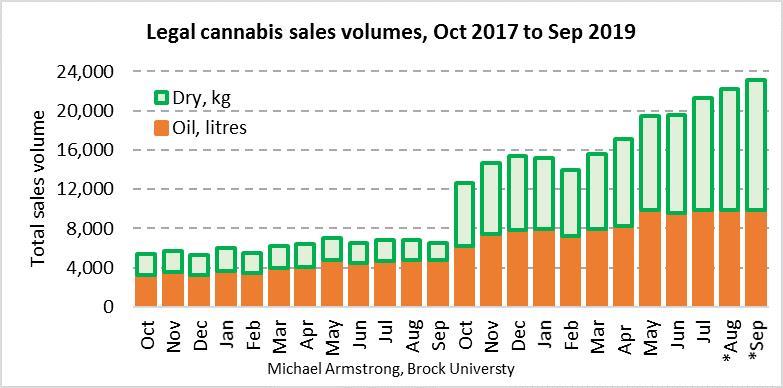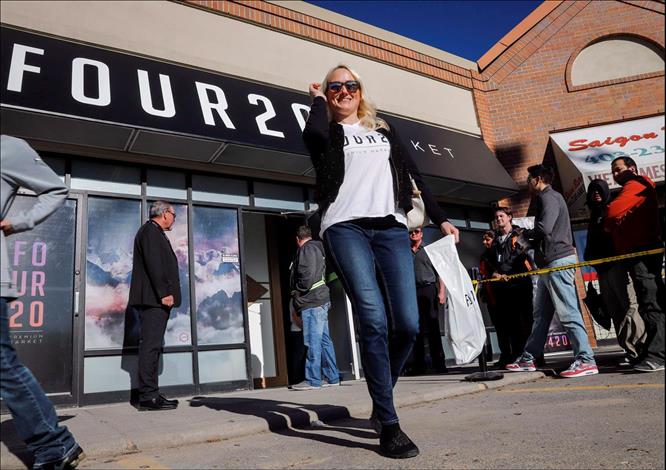
Legal cannabis celebrates its first anniversary in Canada: What's next?
(MENAFN- The Conversation) This week marks the first anniversary of Canada's recreational cannabis legalization. It's an appropriate time to review what happened last year and consider what's coming next.
Legalization brought big changes for some folks. About9,200 employeesnow work at cannabis producers, with thousands more at retailers. Unfortunately,company profits remain scarceandtax revenues are modest .
By contrast, cannabis users are largely unchanged. In the nine months before legalization, an average of14.9 per centof Canadians reported using cannabis. That increased by only one-tenth, to 16.3 per cent, during the nine months after.
However, those users have increasingly bought their cannabis legally.
Sales grew
Health Canada datashow July's legal recreational and medical sales totalled 11,387 kilograms of dry cannabis and 9,854 litres of cannabis oil. That's the fifth consecutive month of expanding sales.
Assuming the growth trend continued into August and September, legal products might now constitute 30 per cent ofCanada's estimated consumption . Legal home growers likely supply a few percentage points more.
That's a big improvement from September 2018, when legal sales represented only eight per cent of national demand. But illegal suppliers still control most of the market.

Monthly volumes of dry (kilograms) and oil (litres) products, recreational and medical cannabis combined. August and September 2019 values are estimated. Prepared by author from Health Canada data.
Michael Armstrong
Producers and retailers expanded
The limited sales success was largely due toongoing shortages of dry cannabis productsthroughout fall and winter. But supplies began improving in spring.
Alongside improving supplies came expanding retail networks. Canada had just over 100 licensed stores in October 2018, but now has more than 550.
Some of those have succeeded wildly. Québec's government-owned outlets each averaged$940,000 in monthly sales over the summer . Ontario's private retailers likely did too.
But the high sales per store were largely due to having few stores per province. The store scarcity meant legal cannabis captured merely a fraction of each province's market.
By contrast, Alberta and New Brunswick have far more retailers per capita, letting legal cannabis seize bigger market shares. But New Brunswick's outlets averagedjust $150,000 eachin monthly sales, while Alberta's shops did only slightly better.
So, low store density is good for retailer profitability but not for public policy.
From the latter perspective, Alberta's retailing approach appears inspired. It had 65 stores open in November, more than any other province.It now has 301 , more than all other provinces combined.

Customers leave a Calgary store after purchasing legal cannabis as other wait to get in on Oct. 17, 2018.
THE CANADIAN PRESS/Jeff McIntosh
Conversely, Ontario's approach increasingly seems misguided. Itsinitial 25-store limitwas reasonable, given last December's shortages of products and information. But its July decision tolicense only 50 more shopswas far too timid, given how much supplies had improved.
Policies need review
In fact, this is a good time for all governments to revisit their cannabis strategies. But any resulting updates should reflect their newfound experience, not their ideological reflexes.
Consider Québec's good example. It recently announced plans todouble its store countby spring, thereby improving access for its large population.
Ontario should follow that lead. As itsChamber of Commerce argued last month , the province needs more retailers and clear processes for adding them.
Meanwhile, New Brunswick is consideringprivatizing its money-losing cannabis retailer . But it might be better to follow Nova Scotia's example and put itscannabis shops inside liquor stores . That would maintain accessibility while lowering operating costs.
Provinces should also rethink store ownership limits. To ensure competition, Alberta forbids any company from holding more than 15 per cent of all retail licences. That's about 45 shops, reasonable enough given the province's size.
By contrast, Ontario limits chains to only75 sites , too few for its large population. AndBritish Columbia restricts them to eight , dooming retailers to inefficiency.
Provinces should review cannabis pricing too. Québec charges retail prices just28 per centabove what it pays producers. That makes legal products competitive with illicit ones.
By contrast, price mark-ups apparently average54 per cent in New Brunswick ,74 per cent in Ontarioand90 per cent in Newfoundland . That generates more revenue but gives black markets big advantages.
This pricing issue will grow more important as Canada's cannabis market evolves in the years ahead.
Coming competition
Until recently, the main limits on legal cannabis' success have been shortages of products and stores. But with those improving, the new challenges will be tocompete with black marketson price and quality.
That means legal prices must drop, at least for value-priced products. Other provinces should follow Québec's lead on that.
Meanwhile, producers must continuously improve theirproduct qualityto offer aromas, potencies and effects comparable to the best illicit weed.
The arrival of cannabis foods, drinks, vapes and lotions in late December should also help. They're important becauseabout a quarter of cannabis usageinvolves foods and vapes. Plus, those value-added products provide licensed producers withexcellent opportunities to distinguish themselvesfrom illegal suppliers.
Cannabis beverages will be particularly interesting to watch. Will they partly replace alcohol as a social beverage, asmany producers hope ? Or will they remain a niche product?
Of course, illegal suppliers will also bedropping their pricesand improving their products. Consequently, the more legal sales grow, the tougher it will be to grow them further. And that dynamic could make legalization's first year, despite all its stumbles, look like the easy part.
[ Like what you've read? Want more?Sign up for The Conversation's daily newsletter . ]
-
Marijuana
-
Cannabis
-
Weed
-
Edibles
-
Canada cannabis legalization

Legal Disclaimer:
MENAFN provides the
information “as is” without warranty of any kind. We do not accept
any responsibility or liability for the accuracy, content, images,
videos, licenses, completeness, legality, or reliability of the information
contained in this article. If you have any complaints or copyright
issues related to this article, kindly contact the provider above.


















Comments
No comment